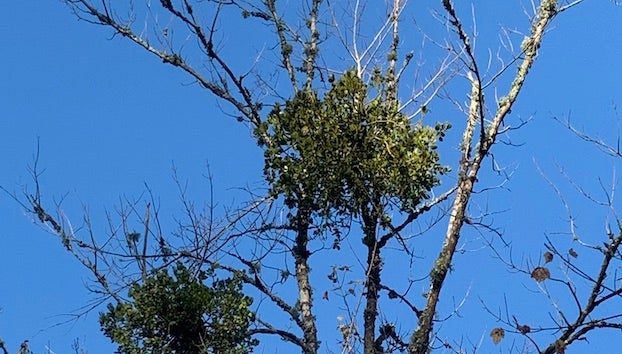Why are parts of my tree staying green?
Published 4:44 pm Wednesday, November 16, 2022
|
Getting your Trinity Audio player ready...
|
This caller noticed clumps of leaves that were not turning this Fall and wanted to know what was wrong with the tree. This is a common site as the leaves drop here in Eastern NC. The green globs of leaves as the caller so aptly described, are clumps of Mistletoe (Phoradendron leaucarpum).
Mistletoe is a small evergreen plant with opposite, simple, oblong, and leathery leaves. You will find it in several different species of trees but most notably Pecan, Red Maple, and Water Oak. It grows very slowly to a full size of about three feet in diameter. The shape is typically rounded like a globe. There are male and female plants. The males produce pollen and the females produce white berries. The white berries are consumed by birds and then seeds are deposited on branches. The seeds stick to the branch of the host tree and then drop anchor into the bark.
The question remains, is this harmful to the tree? The short answer is yes, mistletoe is a parasite on trees. Although it does perform photosynthesis, it also feeds off of the tree. The plant taps into the tree’s xylem and feeds on the nutrient rich water coming from the soil. It can be a problem especially in dry years like we have experienced this season.
A small infestation is not very harmful to the tree and shouldn’t warrant another glance. Mistletoe is native to the area adding both diversity and wildlife value to the ecosystem. But larger infestations can rob too much water and nutrition from the host plant. In a season such as this one, a large infestation in an otherwise water loving tree, such as red maple, could spell disaster. You can prune infested branches out but this will most likely not eradicate mistletoe. It is best to water trees during times of drought. Mulching around roots away from the trunk of the tree can moderate soil temperature and moisture levels as well as protect the tree from mechanical damage. If there is a large infestation, I would suggest contacting a certified arborist through the International Society of Arborists. Certified arborists can be found at www.treesaregood.org.
What about using fresh mistletoe for an ornament this time of year? We all know how the song goes, “Everybody knows, a turkey and some mistletoe…” Be careful using mistletoe around children and pets, it is poisonous! The berries and foliage are both toxic. Stomach and intestinal irritation with possible diarrhea, lowered blood pressure, and slow pulse may occur if consumed.
You might want to find another way to steal that kiss this season!
If you have a question to submit, please email to Gene Fox at gene_fox@ncsu.edu. Having trouble with growing in your home landscape, call the Extension office and speak to an Extension Master Gardener VolunteerSM (EMGV’s), Mondays and Wednesdays between 10:00 and 12:00 at (252)946-0111. Learn more on Facebook at the Blacklands Area Horticulture page or visit the Extension Office located at 155 Airport Road!




